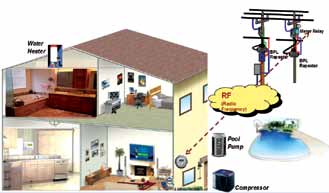What is needed to start is a smart meter with two-way communications. A smart meter would give detailed information on usage, and also enable differential pricing—where the consumer would be billed less for power consumed in lean periods and more in peak hours. This is one of the simplest ways of encouraging the consumer to use energy-guzzling appliances like clothes dryers and dishwashers during non-peak hours.

At another level, with home networking and smart appliances, it is possible for the smart meter to automatically switch appliances on or off depending on the load and corresponding instructions from the utility. This helps the utility in peak load management. Additionally, the utility saves the many man-days spent in meter readings, line connection and disconnection, etc, as these can be done through the smart meters. Losses due to theft, wrong meter readings, technical errors and so on can also be avoided.
“In total, we can say that AT&C losses could be reduced to a great extent, with improvement in reliability and quality of power supply and reduction of establishment charges and repair and maintenance expenses. With these improvements, there may be a reduction in tariff structure,” says Ramesh.
It is very important that such benefits are passed on effectively to the consumers in order to encourage them to implement home area networking and buy smart appliances—which are auxiliary technologies needed to ensure the effectiveness and evolution of smart grids. A smart meter alone is not enough.
For this to happen, Grid Net’s CEO Ray Bel quips that the innovation has to sync with the “gotta see, gotta have” attitude of customers and not happen at the thoughtful, careful speed of utility-side innovation. Consumers need to be tempted with killer apps, including home appliance control, home security systems, video communications, home energy consumption and pricing, home multimedia system controls and more. “With these goodies, consumers will have a plethora of incentives to check in frequently with their Smart Home centre – to see what’s up, to transact (yup, that’s right: e-commerce right on the ‘fourth screen’) and to make intelligent energy resource decisions,” Bell writes in an article.
There are signs of these dreams materialising soon. For one, the industry is slowly converging on the protocols and standards for smart appliances and home networking. Zigbee, for example, is emerging as a popular standard on this front. Newer applications and smart appliances are also emerging on the scene. GE’s product line is one typical example.
“Home energy management (HEM), enabled by the smart grid, is an extension of smart meter deployments that provide interesting benefits for residential customers and utilities. IDC found that customers reduce overall energy use by 4 to 15 per cent when they receive real-time feedback on power consumption. For utilities, HEM solutions open new opportunities for strengthening customer relationships, managing power loads, defending against new competitors and realising new revenue from value-added services,” says Raina of Cisco, which has launched some solutions in this space.
Cisco’s HEM gives residential consumers the ability to see and understand their energy use—and its costs—in real time. The consumer interface is the Home Energy Controller (HEC), a countertop display with an LCD touchscreen that can communicate with other home devices—such as a smart meter, smart plugs and programmable thermostats—to help optimise in-home energy management. The HEC has the potential to do for residential consumers what hybrid drivers can do each time they sit behind the wheel.
At this year’s Consumer Electronics Show, Intel revealed its intelligent in-home device, described as the ‘fourth screen’ for the home (the first three being television, computers and mobile phones). The device is powered by an Intel Atom processor and provides a centralised dashboard manifested on a stylish, technologically-advanced OLED touch screen. It helps the consumers understand their power consumption patterns and automatically schedule and control devices using smart appliances, programmable thermostats, etc.
Industry majors like Microsoft and Google also offer power management solutions. Rumours are that Apple will also be entering this space soon, as it has filed two related patent applications. The proposed energy management system would allow consumers to reduce electricity bills by controlling and maximising how power is allocated to home electronics such as computers, cell phones and even iPods.
Apparently, the home energy management dashboard is not based on any new technology. Data would be transferred through existing home or business wiring with the HomePlug Powerline Network—a plug-in device that essentially turns outlets into high-speed Internet sources. The system would give consumers real-time information on their energy use, how much it costs and the opportunity to do something about it. Whether all this would require a new device or an application that can run on existing ones is not clear yet.
Such innovative devices and solutions that make it fun, exciting and easy for customers to understand and manage their energy consumption would take demand-side management to the next level. To begin with, we could start calling the initiative as ‘smart homes’ rather than in staid technical terms!
Smarter Smart Grids: Looking Into The Future
Current technological developments, research and discussions happening world over indicate that smart grids are going to become smarter than ever before
Homes that give back. One of the key features of a smart grid is its ability to combine power produced from distributed power sources. Hence, theoretically, every home can be producer. If the house is able to produce more energy than it consumes, through solar and other renewable power sources, it can give back to the grid, and get discounts on its bill too. Such an idea was also presented by GE when it demonstrated its vision of a zero net energy house.







